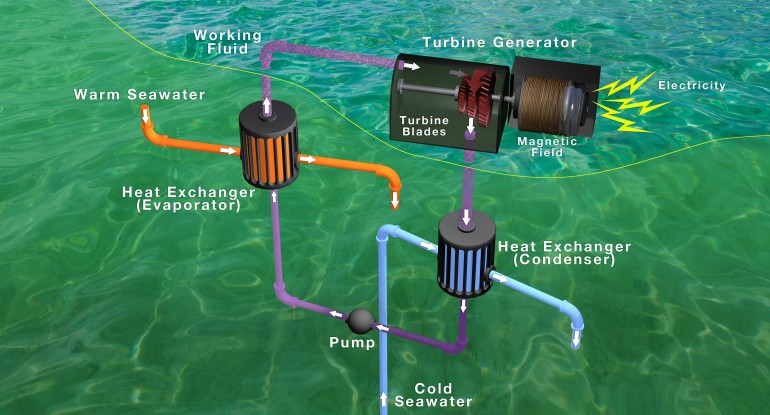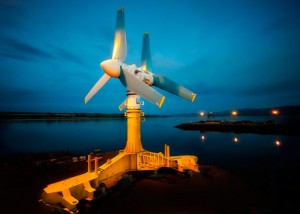Amid further moves into clean energy, Lockheed Martin recently purchased Sun Catalytix for its patents and new business plan to produce affordable “flow batteries” made from low-cost and abundant materials for grid-scale and commercial-scale storage. Sun Catalytix previously aimed to develop an artificial form of photosynthesis called “artificial leaf” to harvest hydrogen from solar energy, but it proved too costly.
Although Lockheed has long been active in clean energy (keep reading for our analysis) its v.p. of new ventures recently stated that the company is giving significant attention to the energy market now.
Sun Catalytix — a spin out of MIT in 2009 — will remain in Cambridge, Mass., and become part of Lockheed’s microgrid technology, which is being used in U.S. military bases to operate securely and independently from the grid.
In July 2013, Sun Catalytix received $4 million in venture funding and was seeking to raise $12 million in total. In 2010, the company raised $9.5 million in Series-B funding from Polaris Venture Partners and Tata Group and won a $4 million grant from the U.S. DOE’s Advanced Research Projects Agency.
In May 2013, the U.S. Army and Lockheed commissioned the first U.S. Department of Defense grid-tied microgrid at Fort Bliss, Texas. Today there are about 25 military microgrid installations in the U.S using technology from companies including flow battery providers ZBB Energy and Primus Power. Navigant Research expects worldwide installations of microgrid capacity to grow from 866MW in 2014 to more than 4,100MW by 2020.
Flow batteries generate energy through chemicals that are used to generate electrochemical reactions in dissolved liquids that flow through a membrane. The key advantage for microgrids is their ability to be rapidly recharged by replacing the electrolyte liquid, while simultaneously recovering spent material, so they last longer than lithium ion batteries. However, they are relatively large and bulky, and the chemicals used in flow batteries to date are expensive.
Despite these current barriers to widespread commercialization, flow batteries are expected to become more economical given the rate of technological advancement over the past year.
Lockheed’s Cleantech Acquisitions & Partnerships Reveal Focus
Traditionally focused on the federal defense industry, Lockheed Martin has been on an acquisition spree lately in order to diversify its business into commercial markets, such as clean energy, due to the anticipated cuts in federal spending on military and space programs. The company’s stated clean energy focus currently includes: energy efficiency, renewable power generation, wave and tidal energy, smart grids, energy storage, and bio-energy.
At a cleantech conference in late 2013, CleantechIQ spoke with a Lockheed engineer who works in one of the company’s business development groups who told us that advanced materials is one of the biggest areas they are tracking, with a particular interest in the developments of graphene-based materials and how they can be applied in water technology in the areas of desalination and ocean thermal energy conversion.
Advanced Materials & Nanotechnology
In addition to Sun Catalytix, Lockheed’s other cleantech-related acquisitions this year include Santa Rosa, CA-based Deposition Sciences in June, which develops highly durable and heat-resistant optical thin-film coatings for its aeronautics division.
The acquisition will provide Lockheed with greater resource efficiency in its manufacturing of military aircraft, as well as applications for thin film coatings in a variety of industrial applications, such as lighting, telecom and data.
And in May, Lockheed announced a new joint venture with Saudi Basic Industries Corporation (Sabic) in Saudi Arabia to develop new carbon nanostructure materials and carbon nanostructure-infused products. Sabic is one of the world’s leading manufacturers of chemicals, fertilizers, plastics and metals.
Lockheed continues to develop advanced materials, including carbon nanostructures and graphene-based materials, for electronics, sensors, energy storage, antennas, and graphene-based water filters, according to the company’s senior manager of advanced materials and nanotechnology.
Electrical Grid Cybersecurity & Smart Grid
In March, Lockheed acquired Mass.-based Industrial Defender, a provider of cyber security solutions for the energy and utilities sector. The acquisition comes amid increased awareness that the nation’s power grid is vulnerable to attack, and includes a recent congressional report on the issue.
In fact, cybersecurity leapt onto the list of the top five concerns for U.S. electric utilities this year, yet only 32 percent had sufficient systems to prevent such an attack, according to a recent survey by Ponemon Institute and Unisys. Utility subsidiaries of ITC holdings, Duke Energy, and NRG Energy have all reported suspected cyber attacks to the U.S. DOE in the past year.
IBM’s smart grid services group is another player in the energy and utility cyber security space.
And in late July, Lockheed received a $300,000 grant from the New York State Energy Research Authority (NYSERDA) to develop and demonstrate smart grid software that combines aerial data with an analytics system to immediately locate power outages or line damage after a major storm. The technology, which is being tested in Lockheed’s Owega, New York office, would allow utilities to accurately assess damage, distribute resources to the right place and resume normal operations quickly and efficiently.
Marine Energy: Ocean Thermal & Wave Energy
Lockheed’s big push for Ocean Thermal Energy Conversion (OTEC)
Lockheed has had a long-standing focus on developing ocean power, having helped build the world’s first successful floating Ocean Thermal Energy Conversion (OTEC) system that generated net power in the 1970s. OTEC uses the natural difference in temperatures found in the ocean’s tropical regions to produce electricity.
In October 2013, Lockheed signed a contract with Beijing-based property developer Reignwood Group to design a 10MW OTEC power plant – the world’s largest OTEC project developed to date. The plant is to be built off the coast of southern China to supply 100 percent of the power needed for a large-scale green resort community Reignwood is developing.
“The benefits to generating power with OTEC are immense, and Lockheed Martin has been leading the way in advancing this technology for decades,” Dan Heller, v.p. of new ventures for Lockheed Martin Mission Systems and Training, said in a press release.
The Reignwood China OTEC plant is designed to pave the way for higher-capacity plants ranging from between 10MW and 100MW.
Experts have estimated that the Reignwood project would cost roughly US $300 million to $500 million, according to IEEE Spectrum. However, experts say that a full-scale 100MW plant would be more price competitive at $1.2 billion.

OTEC Power System
Riding the crest of big wave power potential
In March 2014, Lockheed announced its involvement in a large tidal power project off the coast of Scotland with Singapore-based tidal power developer Atlantis Resources, which had an IPO on London’s AIM exchange in February. The project, called the MeyGen project, raised $83 million from the U.K.’s Department of Energy this August and it signed a 398MW, 25-year seabed lease with The Crown Estate on September 11. Lockheed said that it will optimize the design of Atlantis’s new 1.5MW tidal turbine, the AR1500, and entered into a partnership with Atlantis in 2013 to develop technology, components and projects in the tidal power sector on a global basis.

Lockheed’s AK-1000 Mark II tidal turbines
And in February, Lockheed began working on a 62.5MW wave energy generation project, the world’s largest, off the coast of Australia with Victorian Wave Partners. The project, which received $60 million in grant funding, will use the PowerBuoy wave energy converter technology of Ocean Power Technologies, a public company based in Pennington, New Jersey, that owns Victoria Wave. Lockheed will provide project management, assist with design and production, and perform system integration of the wave energy converters.

Victorian Wave Partners Power Buoy
“The ocean is the largest untapped source of renewable energy this planet has,” said Heller.
The U.S. government has recently committed over $116 million to early stage wave and tidal energy startups and projects.
Waste-to-Energy Technology
In October 2013, Lockheed announced a partnership with waste-to-value firm Concord Blue, founded in 2002, to deploy Concord’s innovative waste conversion technology called steam thermolysis. In December, Concord Blue announced that it will integrate its technology into LanzaTech’s Freedom Pines facility in Soperton, Georgia, in order to convert waste biomass from regional forestry operations into synthetic natural gas. LanzaTech received a $4M ARPA-E grant to develop its waste gas-to-fuel technologies in September 2013 and raised $60 million in Series D venture funding in March 2014.
Lockheed’s website doesn’t list any other active waste conversion projects, so this appears to be a new area for the company. However, it does have a biomass project in Owego, N.Y., that uses wood chips from local sawmills to create steam to help heat and cool a nearly 2 million square foot campus.
Green IT & Data Centers
Having been named a top federal government IT provider for 19 years by Washington Technology, Lockheed successfully relocated the U.S. Department of Labor’s data center in July, 2013, in order to increase its energy efficiency. Lockheed stated that it’s committed to helping its commercial and federal customers achieve their sustainable IT practices, including data center consolidation, cloud computing and virtualization. It has contracts with eight of the top 10 largest utilities in the United States to run energy efficiency programs and provides smart grid and cyber security solutions to its commercial customers, the company said.
Modular Nuclear Fusion Reactors
In early 2013, Lockheed Martin announced that it was planning to begin working on small, modular nuclear fusion reactors in its legendary and secretive Skunk Works facility in California. According to a speech by its program leader, Charles Chase, a prototype 100MW nuclear fusion machine will be tested in 2017, and it expects that a fully operational machine should be grid-ready in the next 10 years.
Sustainable Fisheries & Aquaculture
Environmental concerns in the ocean arising from the proliferation of fish farms and overfishing, driven by growing global demand for seafood, has caught Lockheed’s attention and has sparked its interest in innovative aquaculture technology. In 2012, the company partnered with “mariculture” startup Kampachi Farms of Hawaii on the development of an innovative system for catching fish in the ocean, called the Mobile Fish Pen.
The new system, recognized by TIME Magazine as one of the Top 25 Inventions of 2012, consists of a fish cage that hooks to a barge and drifts with the ocean’s eddies. The mobile system, which is constantly moving over the ocean’s surface in waters over 12,000 feet deep, solves the potential problems of impacts on water quality or impacts on the seafloor, and appears to improve fish health and growth, said the company.
“We took technologies and software developed for defense-related applications and used them to create a sustainable, environmentally sound method of farming, which will undoubtedly have a lasting impact on our oceans and wildlife,” Gerry Fasano, president of Lockheed Martin Information Systems and Global Solutions-Defense, said in a company release.
Kampachi Farms plans to raise venture funding this year, putting it on track to begin selling Kampachi commercially in September, 2015 to the U.S. and Mexico, according to the startup’s CEO. The company has plans to expand into the Middle East as well.
